HCS310 Case Study: David's Story - Community Mental Health Support
VerifiedAdded on 2022/09/30
|7
|3624
|34
Case Study
AI Summary
This case study, centered on David, an 18-year-old experiencing a first episode of psychosis, explores the complexities of community mental health care. It examines the initial professional interaction, including establishing trust and addressing confidentiality, and the role of social workers in supporting David. The analysis delves into the importance of therapeutic relationships, medication management, and addressing potential side effects. The case progresses to David's non-adherence to medication, highlighting the need for on-site assessment, risk factor identification, and engagement strategies, considering physical, cognitive, and behavioral aspects. The study then addresses the family's concerns regarding David's escalating aggression and substance abuse, emphasizing the need for risk assessment, parental support, and ethical considerations. Finally, the case evaluates the actions a casual staff member should have taken when responding to the family's distress, focusing on confidentiality and adherence to protocols. The assignment underscores the importance of comprehensive care, ethical practice, and collaborative efforts in managing mental health conditions within a community setting.
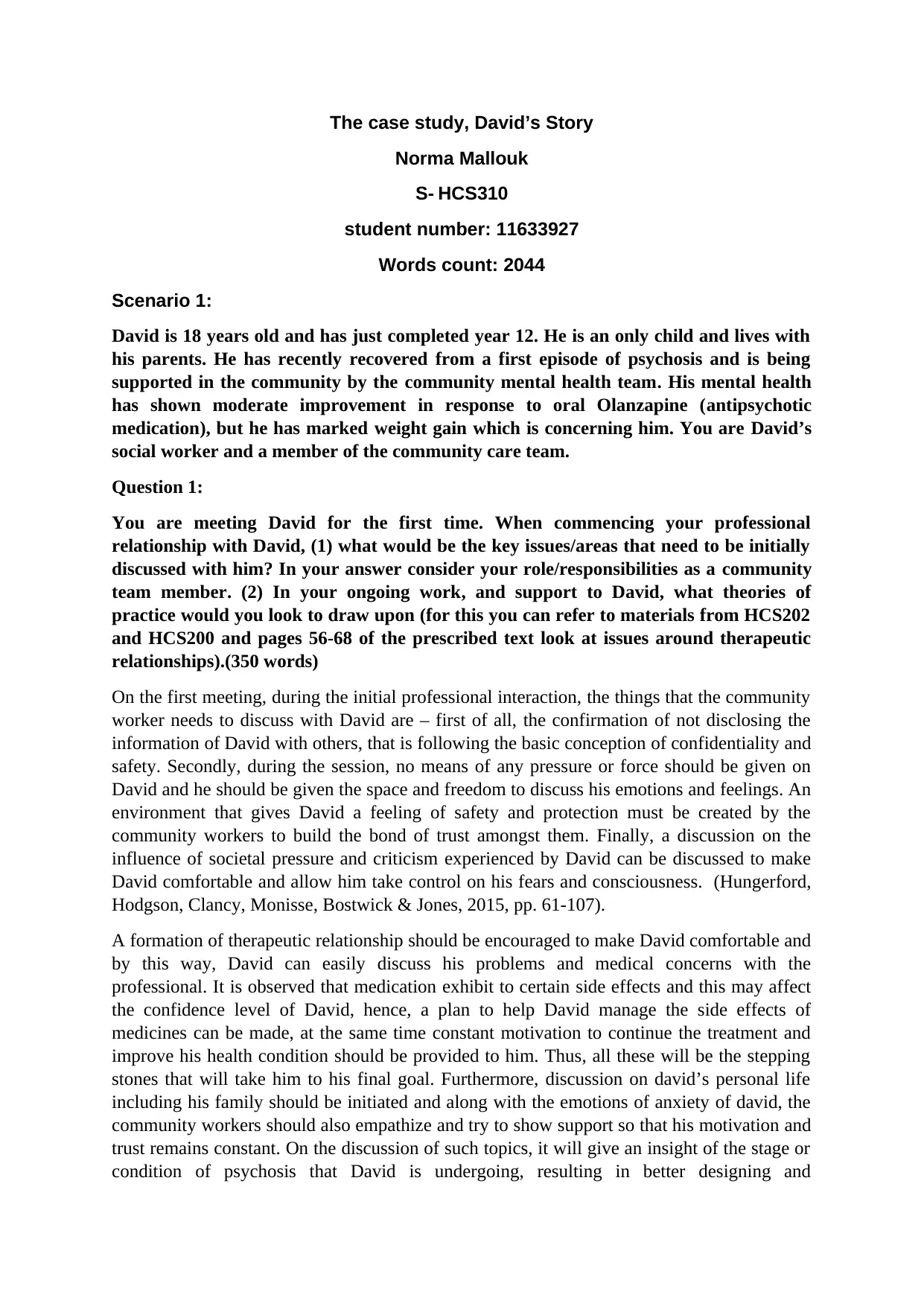
The case study, David’s Story
Norma Mallouk
S- HCS310
student number: 11633927
Words count: 2044
Scenario 1:
David is 18 years old and has just completed year 12. He is an only child and lives with
his parents. He has recently recovered from a first episode of psychosis and is being
supported in the community by the community mental health team. His mental health
has shown moderate improvement in response to oral Olanzapine (antipsychotic
medication), but he has marked weight gain which is concerning him. You are David’s
social worker and a member of the community care team.
Question 1:
You are meeting David for the first time. When commencing your professional
relationship with David, (1) what would be the key issues/areas that need to be initially
discussed with him? In your answer consider your role/responsibilities as a community
team member. (2) In your ongoing work, and support to David, what theories of
practice would you look to draw upon (for this you can refer to materials from HCS202
and HCS200 and pages 56-68 of the prescribed text look at issues around therapeutic
relationships).(350 words)
On the first meeting, during the initial professional interaction, the things that the community
worker needs to discuss with David are – first of all, the confirmation of not disclosing the
information of David with others, that is following the basic conception of confidentiality and
safety. Secondly, during the session, no means of any pressure or force should be given on
David and he should be given the space and freedom to discuss his emotions and feelings. An
environment that gives David a feeling of safety and protection must be created by the
community workers to build the bond of trust amongst them. Finally, a discussion on the
influence of societal pressure and criticism experienced by David can be discussed to make
David comfortable and allow him take control on his fears and consciousness. (Hungerford,
Hodgson, Clancy, Monisse, Bostwick & Jones, 2015, pp. 61-107).
A formation of therapeutic relationship should be encouraged to make David comfortable and
by this way, David can easily discuss his problems and medical concerns with the
professional. It is observed that medication exhibit to certain side effects and this may affect
the confidence level of David, hence, a plan to help David manage the side effects of
medicines can be made, at the same time constant motivation to continue the treatment and
improve his health condition should be provided to him. Thus, all these will be the stepping
stones that will take him to his final goal. Furthermore, discussion on david’s personal life
including his family should be initiated and along with the emotions of anxiety of david, the
community workers should also empathize and try to show support so that his motivation and
trust remains constant. On the discussion of such topics, it will give an insight of the stage or
condition of psychosis that David is undergoing, resulting in better designing and
Norma Mallouk
S- HCS310
student number: 11633927
Words count: 2044
Scenario 1:
David is 18 years old and has just completed year 12. He is an only child and lives with
his parents. He has recently recovered from a first episode of psychosis and is being
supported in the community by the community mental health team. His mental health
has shown moderate improvement in response to oral Olanzapine (antipsychotic
medication), but he has marked weight gain which is concerning him. You are David’s
social worker and a member of the community care team.
Question 1:
You are meeting David for the first time. When commencing your professional
relationship with David, (1) what would be the key issues/areas that need to be initially
discussed with him? In your answer consider your role/responsibilities as a community
team member. (2) In your ongoing work, and support to David, what theories of
practice would you look to draw upon (for this you can refer to materials from HCS202
and HCS200 and pages 56-68 of the prescribed text look at issues around therapeutic
relationships).(350 words)
On the first meeting, during the initial professional interaction, the things that the community
worker needs to discuss with David are – first of all, the confirmation of not disclosing the
information of David with others, that is following the basic conception of confidentiality and
safety. Secondly, during the session, no means of any pressure or force should be given on
David and he should be given the space and freedom to discuss his emotions and feelings. An
environment that gives David a feeling of safety and protection must be created by the
community workers to build the bond of trust amongst them. Finally, a discussion on the
influence of societal pressure and criticism experienced by David can be discussed to make
David comfortable and allow him take control on his fears and consciousness. (Hungerford,
Hodgson, Clancy, Monisse, Bostwick & Jones, 2015, pp. 61-107).
A formation of therapeutic relationship should be encouraged to make David comfortable and
by this way, David can easily discuss his problems and medical concerns with the
professional. It is observed that medication exhibit to certain side effects and this may affect
the confidence level of David, hence, a plan to help David manage the side effects of
medicines can be made, at the same time constant motivation to continue the treatment and
improve his health condition should be provided to him. Thus, all these will be the stepping
stones that will take him to his final goal. Furthermore, discussion on david’s personal life
including his family should be initiated and along with the emotions of anxiety of david, the
community workers should also empathize and try to show support so that his motivation and
trust remains constant. On the discussion of such topics, it will give an insight of the stage or
condition of psychosis that David is undergoing, resulting in better designing and
Paraphrase This Document
Need a fresh take? Get an instant paraphrase of this document with our AI Paraphraser
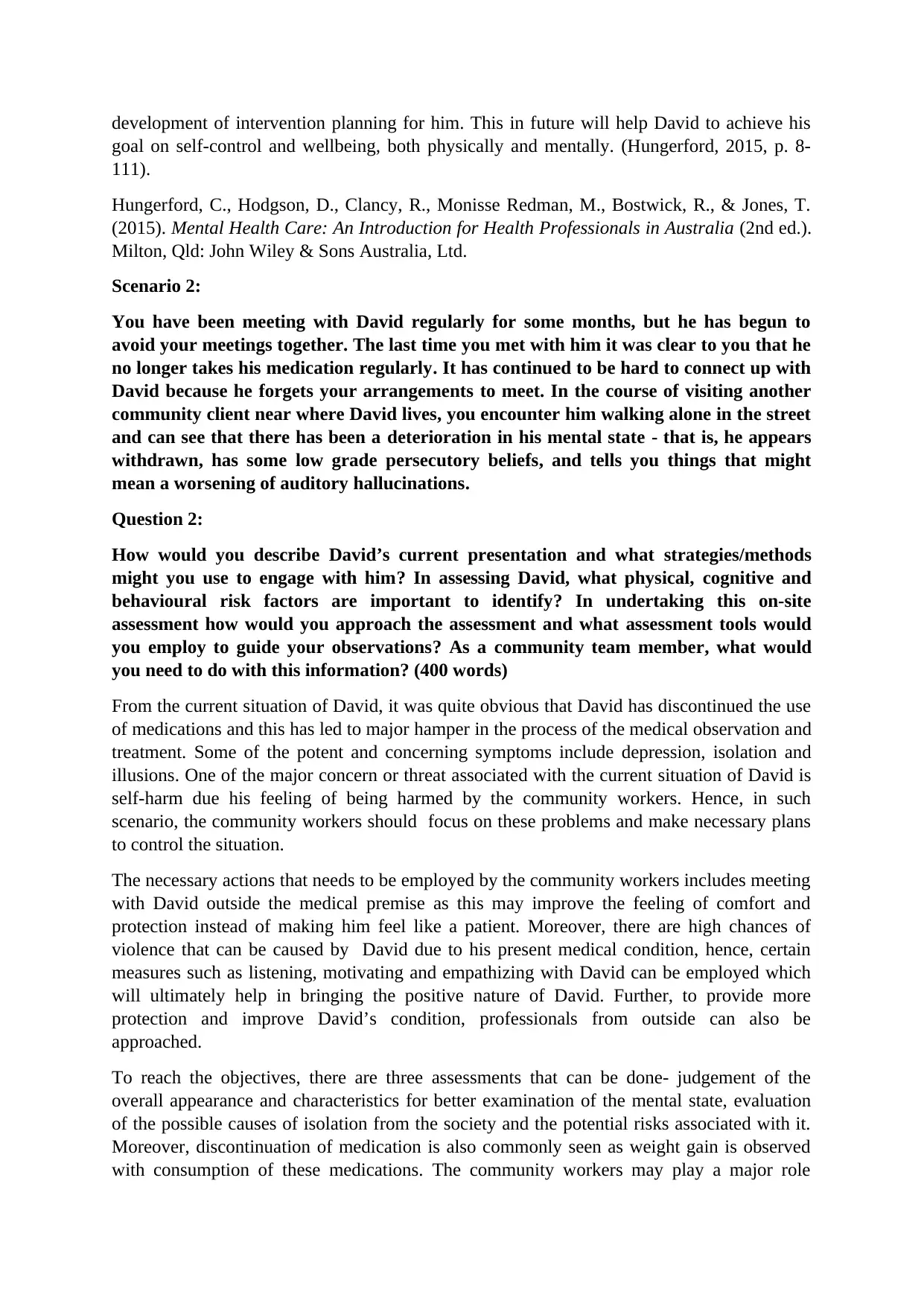
development of intervention planning for him. This in future will help David to achieve his
goal on self-control and wellbeing, both physically and mentally. (Hungerford, 2015, p. 8-
111).
Hungerford, C., Hodgson, D., Clancy, R., Monisse Redman, M., Bostwick, R., & Jones, T.
(2015). Mental Health Care: An Introduction for Health Professionals in Australia (2nd ed.).
Milton, Qld: John Wiley & Sons Australia, Ltd.
Scenario 2:
You have been meeting with David regularly for some months, but he has begun to
avoid your meetings together. The last time you met with him it was clear to you that he
no longer takes his medication regularly. It has continued to be hard to connect up with
David because he forgets your arrangements to meet. In the course of visiting another
community client near where David lives, you encounter him walking alone in the street
and can see that there has been a deterioration in his mental state - that is, he appears
withdrawn, has some low grade persecutory beliefs, and tells you things that might
mean a worsening of auditory hallucinations.
Question 2:
How would you describe David’s current presentation and what strategies/methods
might you use to engage with him? In assessing David, what physical, cognitive and
behavioural risk factors are important to identify? In undertaking this on-site
assessment how would you approach the assessment and what assessment tools would
you employ to guide your observations? As a community team member, what would
you need to do with this information? (400 words)
From the current situation of David, it was quite obvious that David has discontinued the use
of medications and this has led to major hamper in the process of the medical observation and
treatment. Some of the potent and concerning symptoms include depression, isolation and
illusions. One of the major concern or threat associated with the current situation of David is
self-harm due his feeling of being harmed by the community workers. Hence, in such
scenario, the community workers should focus on these problems and make necessary plans
to control the situation.
The necessary actions that needs to be employed by the community workers includes meeting
with David outside the medical premise as this may improve the feeling of comfort and
protection instead of making him feel like a patient. Moreover, there are high chances of
violence that can be caused by David due to his present medical condition, hence, certain
measures such as listening, motivating and empathizing with David can be employed which
will ultimately help in bringing the positive nature of David. Further, to provide more
protection and improve David’s condition, professionals from outside can also be
approached.
To reach the objectives, there are three assessments that can be done- judgement of the
overall appearance and characteristics for better examination of the mental state, evaluation
of the possible causes of isolation from the society and the potential risks associated with it.
Moreover, discontinuation of medication is also commonly seen as weight gain is observed
with consumption of these medications. The community workers may play a major role
goal on self-control and wellbeing, both physically and mentally. (Hungerford, 2015, p. 8-
111).
Hungerford, C., Hodgson, D., Clancy, R., Monisse Redman, M., Bostwick, R., & Jones, T.
(2015). Mental Health Care: An Introduction for Health Professionals in Australia (2nd ed.).
Milton, Qld: John Wiley & Sons Australia, Ltd.
Scenario 2:
You have been meeting with David regularly for some months, but he has begun to
avoid your meetings together. The last time you met with him it was clear to you that he
no longer takes his medication regularly. It has continued to be hard to connect up with
David because he forgets your arrangements to meet. In the course of visiting another
community client near where David lives, you encounter him walking alone in the street
and can see that there has been a deterioration in his mental state - that is, he appears
withdrawn, has some low grade persecutory beliefs, and tells you things that might
mean a worsening of auditory hallucinations.
Question 2:
How would you describe David’s current presentation and what strategies/methods
might you use to engage with him? In assessing David, what physical, cognitive and
behavioural risk factors are important to identify? In undertaking this on-site
assessment how would you approach the assessment and what assessment tools would
you employ to guide your observations? As a community team member, what would
you need to do with this information? (400 words)
From the current situation of David, it was quite obvious that David has discontinued the use
of medications and this has led to major hamper in the process of the medical observation and
treatment. Some of the potent and concerning symptoms include depression, isolation and
illusions. One of the major concern or threat associated with the current situation of David is
self-harm due his feeling of being harmed by the community workers. Hence, in such
scenario, the community workers should focus on these problems and make necessary plans
to control the situation.
The necessary actions that needs to be employed by the community workers includes meeting
with David outside the medical premise as this may improve the feeling of comfort and
protection instead of making him feel like a patient. Moreover, there are high chances of
violence that can be caused by David due to his present medical condition, hence, certain
measures such as listening, motivating and empathizing with David can be employed which
will ultimately help in bringing the positive nature of David. Further, to provide more
protection and improve David’s condition, professionals from outside can also be
approached.
To reach the objectives, there are three assessments that can be done- judgement of the
overall appearance and characteristics for better examination of the mental state, evaluation
of the possible causes of isolation from the society and the potential risks associated with it.
Moreover, discontinuation of medication is also commonly seen as weight gain is observed
with consumption of these medications. The community workers may play a major role
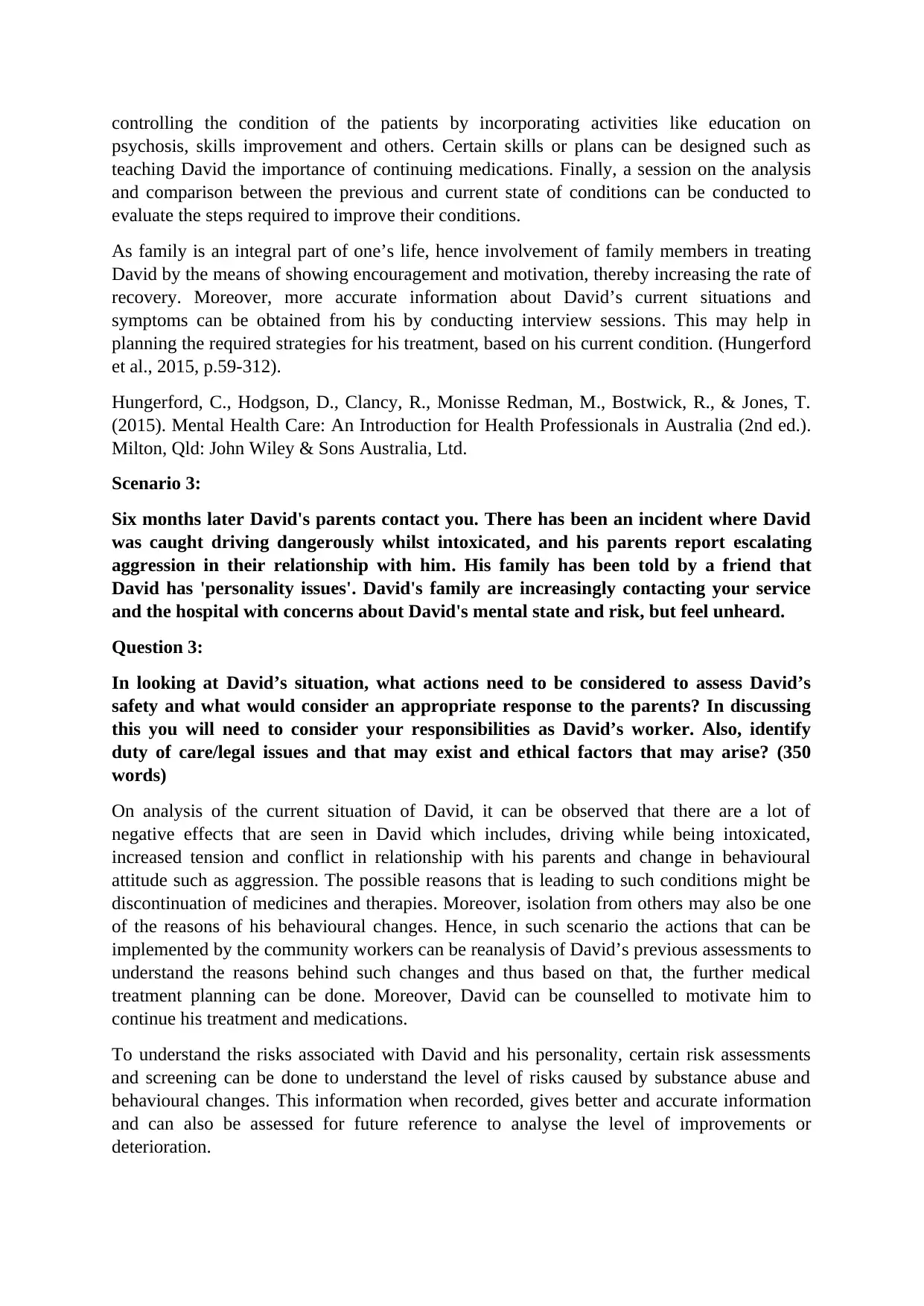
controlling the condition of the patients by incorporating activities like education on
psychosis, skills improvement and others. Certain skills or plans can be designed such as
teaching David the importance of continuing medications. Finally, a session on the analysis
and comparison between the previous and current state of conditions can be conducted to
evaluate the steps required to improve their conditions.
As family is an integral part of one’s life, hence involvement of family members in treating
David by the means of showing encouragement and motivation, thereby increasing the rate of
recovery. Moreover, more accurate information about David’s current situations and
symptoms can be obtained from his by conducting interview sessions. This may help in
planning the required strategies for his treatment, based on his current condition. (Hungerford
et al., 2015, p.59-312).
Hungerford, C., Hodgson, D., Clancy, R., Monisse Redman, M., Bostwick, R., & Jones, T.
(2015). Mental Health Care: An Introduction for Health Professionals in Australia (2nd ed.).
Milton, Qld: John Wiley & Sons Australia, Ltd.
Scenario 3:
Six months later David's parents contact you. There has been an incident where David
was caught driving dangerously whilst intoxicated, and his parents report escalating
aggression in their relationship with him. His family has been told by a friend that
David has 'personality issues'. David's family are increasingly contacting your service
and the hospital with concerns about David's mental state and risk, but feel unheard.
Question 3:
In looking at David’s situation, what actions need to be considered to assess David’s
safety and what would consider an appropriate response to the parents? In discussing
this you will need to consider your responsibilities as David’s worker. Also, identify
duty of care/legal issues and that may exist and ethical factors that may arise? (350
words)
On analysis of the current situation of David, it can be observed that there are a lot of
negative effects that are seen in David which includes, driving while being intoxicated,
increased tension and conflict in relationship with his parents and change in behavioural
attitude such as aggression. The possible reasons that is leading to such conditions might be
discontinuation of medicines and therapies. Moreover, isolation from others may also be one
of the reasons of his behavioural changes. Hence, in such scenario the actions that can be
implemented by the community workers can be reanalysis of David’s previous assessments to
understand the reasons behind such changes and thus based on that, the further medical
treatment planning can be done. Moreover, David can be counselled to motivate him to
continue his treatment and medications.
To understand the risks associated with David and his personality, certain risk assessments
and screening can be done to understand the level of risks caused by substance abuse and
behavioural changes. This information when recorded, gives better and accurate information
and can also be assessed for future reference to analyse the level of improvements or
deterioration.
psychosis, skills improvement and others. Certain skills or plans can be designed such as
teaching David the importance of continuing medications. Finally, a session on the analysis
and comparison between the previous and current state of conditions can be conducted to
evaluate the steps required to improve their conditions.
As family is an integral part of one’s life, hence involvement of family members in treating
David by the means of showing encouragement and motivation, thereby increasing the rate of
recovery. Moreover, more accurate information about David’s current situations and
symptoms can be obtained from his by conducting interview sessions. This may help in
planning the required strategies for his treatment, based on his current condition. (Hungerford
et al., 2015, p.59-312).
Hungerford, C., Hodgson, D., Clancy, R., Monisse Redman, M., Bostwick, R., & Jones, T.
(2015). Mental Health Care: An Introduction for Health Professionals in Australia (2nd ed.).
Milton, Qld: John Wiley & Sons Australia, Ltd.
Scenario 3:
Six months later David's parents contact you. There has been an incident where David
was caught driving dangerously whilst intoxicated, and his parents report escalating
aggression in their relationship with him. His family has been told by a friend that
David has 'personality issues'. David's family are increasingly contacting your service
and the hospital with concerns about David's mental state and risk, but feel unheard.
Question 3:
In looking at David’s situation, what actions need to be considered to assess David’s
safety and what would consider an appropriate response to the parents? In discussing
this you will need to consider your responsibilities as David’s worker. Also, identify
duty of care/legal issues and that may exist and ethical factors that may arise? (350
words)
On analysis of the current situation of David, it can be observed that there are a lot of
negative effects that are seen in David which includes, driving while being intoxicated,
increased tension and conflict in relationship with his parents and change in behavioural
attitude such as aggression. The possible reasons that is leading to such conditions might be
discontinuation of medicines and therapies. Moreover, isolation from others may also be one
of the reasons of his behavioural changes. Hence, in such scenario the actions that can be
implemented by the community workers can be reanalysis of David’s previous assessments to
understand the reasons behind such changes and thus based on that, the further medical
treatment planning can be done. Moreover, David can be counselled to motivate him to
continue his treatment and medications.
To understand the risks associated with David and his personality, certain risk assessments
and screening can be done to understand the level of risks caused by substance abuse and
behavioural changes. This information when recorded, gives better and accurate information
and can also be assessed for future reference to analyse the level of improvements or
deterioration.
⊘ This is a preview!⊘
Do you want full access?
Subscribe today to unlock all pages.

Trusted by 1+ million students worldwide
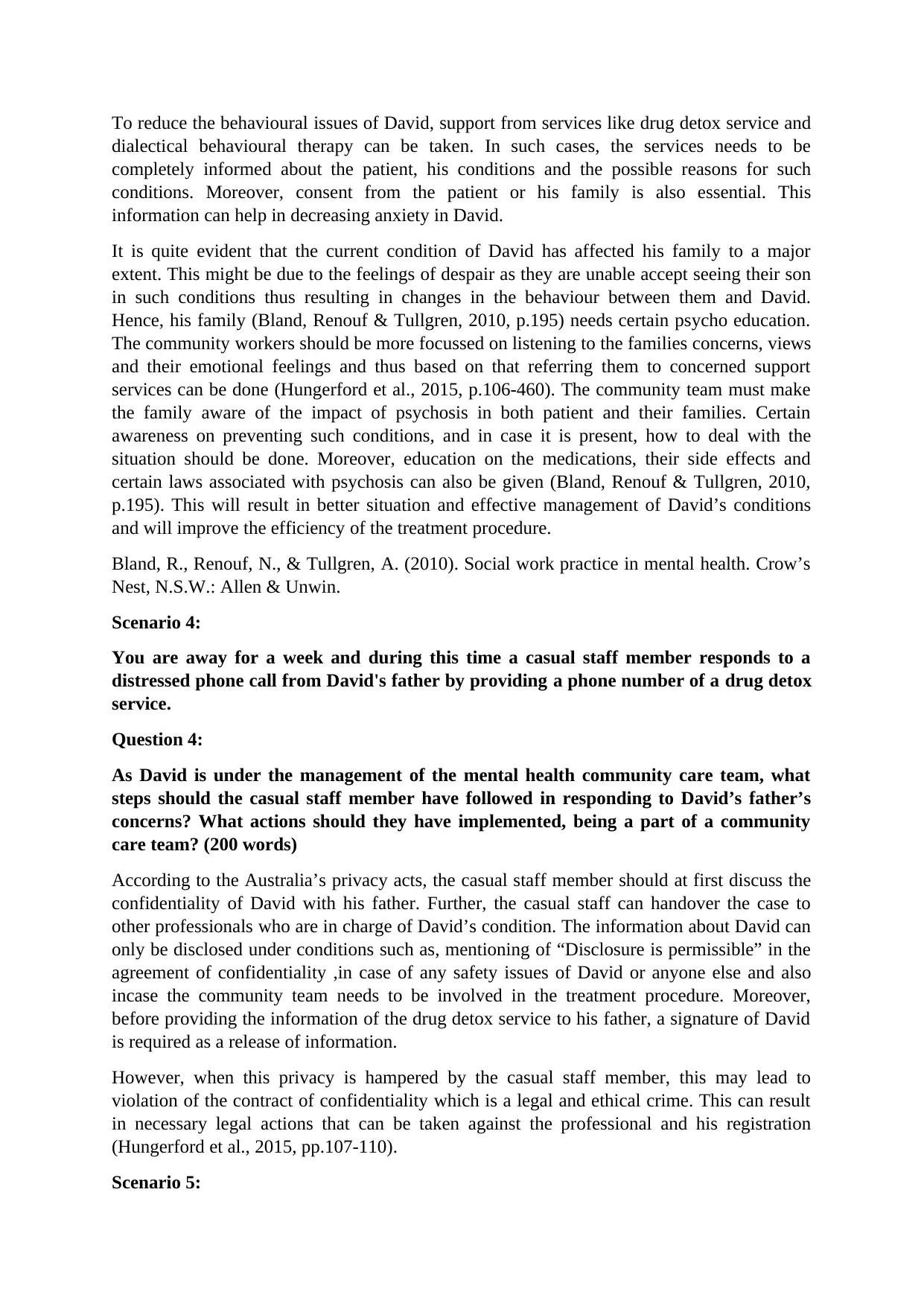
To reduce the behavioural issues of David, support from services like drug detox service and
dialectical behavioural therapy can be taken. In such cases, the services needs to be
completely informed about the patient, his conditions and the possible reasons for such
conditions. Moreover, consent from the patient or his family is also essential. This
information can help in decreasing anxiety in David.
It is quite evident that the current condition of David has affected his family to a major
extent. This might be due to the feelings of despair as they are unable accept seeing their son
in such conditions thus resulting in changes in the behaviour between them and David.
Hence, his family (Bland, Renouf & Tullgren, 2010, p.195) needs certain psycho education.
The community workers should be more focussed on listening to the families concerns, views
and their emotional feelings and thus based on that referring them to concerned support
services can be done (Hungerford et al., 2015, p.106-460). The community team must make
the family aware of the impact of psychosis in both patient and their families. Certain
awareness on preventing such conditions, and in case it is present, how to deal with the
situation should be done. Moreover, education on the medications, their side effects and
certain laws associated with psychosis can also be given (Bland, Renouf & Tullgren, 2010,
p.195). This will result in better situation and effective management of David’s conditions
and will improve the efficiency of the treatment procedure.
Bland, R., Renouf, N., & Tullgren, A. (2010). Social work practice in mental health. Crow’s
Nest, N.S.W.: Allen & Unwin.
Scenario 4:
You are away for a week and during this time a casual staff member responds to a
distressed phone call from David's father by providing a phone number of a drug detox
service.
Question 4:
As David is under the management of the mental health community care team, what
steps should the casual staff member have followed in responding to David’s father’s
concerns? What actions should they have implemented, being a part of a community
care team? (200 words)
According to the Australia’s privacy acts, the casual staff member should at first discuss the
confidentiality of David with his father. Further, the casual staff can handover the case to
other professionals who are in charge of David’s condition. The information about David can
only be disclosed under conditions such as, mentioning of “Disclosure is permissible” in the
agreement of confidentiality ,in case of any safety issues of David or anyone else and also
incase the community team needs to be involved in the treatment procedure. Moreover,
before providing the information of the drug detox service to his father, a signature of David
is required as a release of information.
However, when this privacy is hampered by the casual staff member, this may lead to
violation of the contract of confidentiality which is a legal and ethical crime. This can result
in necessary legal actions that can be taken against the professional and his registration
(Hungerford et al., 2015, pp.107-110).
Scenario 5:
dialectical behavioural therapy can be taken. In such cases, the services needs to be
completely informed about the patient, his conditions and the possible reasons for such
conditions. Moreover, consent from the patient or his family is also essential. This
information can help in decreasing anxiety in David.
It is quite evident that the current condition of David has affected his family to a major
extent. This might be due to the feelings of despair as they are unable accept seeing their son
in such conditions thus resulting in changes in the behaviour between them and David.
Hence, his family (Bland, Renouf & Tullgren, 2010, p.195) needs certain psycho education.
The community workers should be more focussed on listening to the families concerns, views
and their emotional feelings and thus based on that referring them to concerned support
services can be done (Hungerford et al., 2015, p.106-460). The community team must make
the family aware of the impact of psychosis in both patient and their families. Certain
awareness on preventing such conditions, and in case it is present, how to deal with the
situation should be done. Moreover, education on the medications, their side effects and
certain laws associated with psychosis can also be given (Bland, Renouf & Tullgren, 2010,
p.195). This will result in better situation and effective management of David’s conditions
and will improve the efficiency of the treatment procedure.
Bland, R., Renouf, N., & Tullgren, A. (2010). Social work practice in mental health. Crow’s
Nest, N.S.W.: Allen & Unwin.
Scenario 4:
You are away for a week and during this time a casual staff member responds to a
distressed phone call from David's father by providing a phone number of a drug detox
service.
Question 4:
As David is under the management of the mental health community care team, what
steps should the casual staff member have followed in responding to David’s father’s
concerns? What actions should they have implemented, being a part of a community
care team? (200 words)
According to the Australia’s privacy acts, the casual staff member should at first discuss the
confidentiality of David with his father. Further, the casual staff can handover the case to
other professionals who are in charge of David’s condition. The information about David can
only be disclosed under conditions such as, mentioning of “Disclosure is permissible” in the
agreement of confidentiality ,in case of any safety issues of David or anyone else and also
incase the community team needs to be involved in the treatment procedure. Moreover,
before providing the information of the drug detox service to his father, a signature of David
is required as a release of information.
However, when this privacy is hampered by the casual staff member, this may lead to
violation of the contract of confidentiality which is a legal and ethical crime. This can result
in necessary legal actions that can be taken against the professional and his registration
(Hungerford et al., 2015, pp.107-110).
Scenario 5:
Paraphrase This Document
Need a fresh take? Get an instant paraphrase of this document with our AI Paraphraser
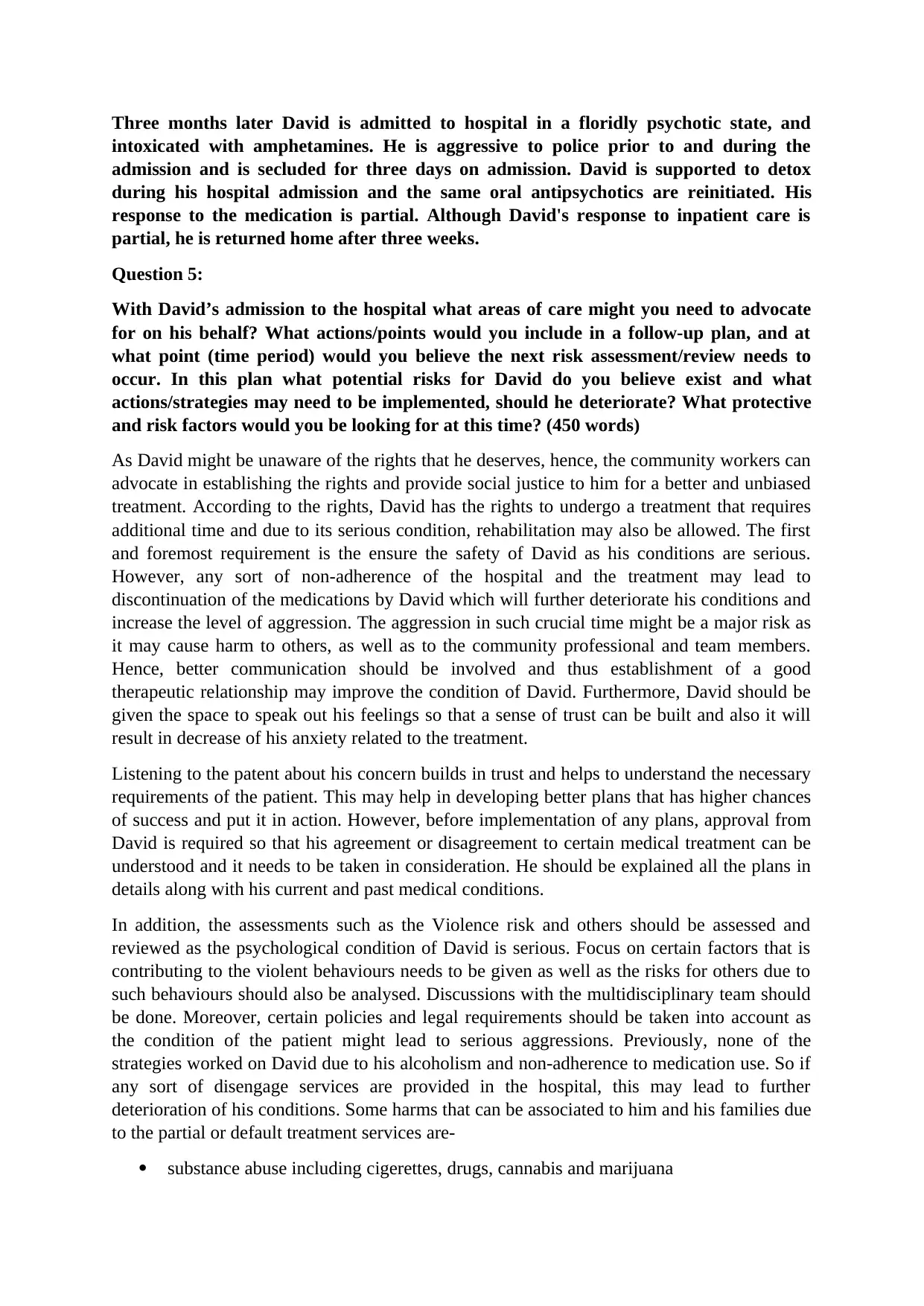
Three months later David is admitted to hospital in a floridly psychotic state, and
intoxicated with amphetamines. He is aggressive to police prior to and during the
admission and is secluded for three days on admission. David is supported to detox
during his hospital admission and the same oral antipsychotics are reinitiated. His
response to the medication is partial. Although David's response to inpatient care is
partial, he is returned home after three weeks.
Question 5:
With David’s admission to the hospital what areas of care might you need to advocate
for on his behalf? What actions/points would you include in a follow-up plan, and at
what point (time period) would you believe the next risk assessment/review needs to
occur. In this plan what potential risks for David do you believe exist and what
actions/strategies may need to be implemented, should he deteriorate? What protective
and risk factors would you be looking for at this time? (450 words)
As David might be unaware of the rights that he deserves, hence, the community workers can
advocate in establishing the rights and provide social justice to him for a better and unbiased
treatment. According to the rights, David has the rights to undergo a treatment that requires
additional time and due to its serious condition, rehabilitation may also be allowed. The first
and foremost requirement is the ensure the safety of David as his conditions are serious.
However, any sort of non-adherence of the hospital and the treatment may lead to
discontinuation of the medications by David which will further deteriorate his conditions and
increase the level of aggression. The aggression in such crucial time might be a major risk as
it may cause harm to others, as well as to the community professional and team members.
Hence, better communication should be involved and thus establishment of a good
therapeutic relationship may improve the condition of David. Furthermore, David should be
given the space to speak out his feelings so that a sense of trust can be built and also it will
result in decrease of his anxiety related to the treatment.
Listening to the patent about his concern builds in trust and helps to understand the necessary
requirements of the patient. This may help in developing better plans that has higher chances
of success and put it in action. However, before implementation of any plans, approval from
David is required so that his agreement or disagreement to certain medical treatment can be
understood and it needs to be taken in consideration. He should be explained all the plans in
details along with his current and past medical conditions.
In addition, the assessments such as the Violence risk and others should be assessed and
reviewed as the psychological condition of David is serious. Focus on certain factors that is
contributing to the violent behaviours needs to be given as well as the risks for others due to
such behaviours should also be analysed. Discussions with the multidisciplinary team should
be done. Moreover, certain policies and legal requirements should be taken into account as
the condition of the patient might lead to serious aggressions. Previously, none of the
strategies worked on David due to his alcoholism and non-adherence to medication use. So if
any sort of disengage services are provided in the hospital, this may lead to further
deterioration of his conditions. Some harms that can be associated to him and his families due
to the partial or default treatment services are-
substance abuse including cigerettes, drugs, cannabis and marijuana
intoxicated with amphetamines. He is aggressive to police prior to and during the
admission and is secluded for three days on admission. David is supported to detox
during his hospital admission and the same oral antipsychotics are reinitiated. His
response to the medication is partial. Although David's response to inpatient care is
partial, he is returned home after three weeks.
Question 5:
With David’s admission to the hospital what areas of care might you need to advocate
for on his behalf? What actions/points would you include in a follow-up plan, and at
what point (time period) would you believe the next risk assessment/review needs to
occur. In this plan what potential risks for David do you believe exist and what
actions/strategies may need to be implemented, should he deteriorate? What protective
and risk factors would you be looking for at this time? (450 words)
As David might be unaware of the rights that he deserves, hence, the community workers can
advocate in establishing the rights and provide social justice to him for a better and unbiased
treatment. According to the rights, David has the rights to undergo a treatment that requires
additional time and due to its serious condition, rehabilitation may also be allowed. The first
and foremost requirement is the ensure the safety of David as his conditions are serious.
However, any sort of non-adherence of the hospital and the treatment may lead to
discontinuation of the medications by David which will further deteriorate his conditions and
increase the level of aggression. The aggression in such crucial time might be a major risk as
it may cause harm to others, as well as to the community professional and team members.
Hence, better communication should be involved and thus establishment of a good
therapeutic relationship may improve the condition of David. Furthermore, David should be
given the space to speak out his feelings so that a sense of trust can be built and also it will
result in decrease of his anxiety related to the treatment.
Listening to the patent about his concern builds in trust and helps to understand the necessary
requirements of the patient. This may help in developing better plans that has higher chances
of success and put it in action. However, before implementation of any plans, approval from
David is required so that his agreement or disagreement to certain medical treatment can be
understood and it needs to be taken in consideration. He should be explained all the plans in
details along with his current and past medical conditions.
In addition, the assessments such as the Violence risk and others should be assessed and
reviewed as the psychological condition of David is serious. Focus on certain factors that is
contributing to the violent behaviours needs to be given as well as the risks for others due to
such behaviours should also be analysed. Discussions with the multidisciplinary team should
be done. Moreover, certain policies and legal requirements should be taken into account as
the condition of the patient might lead to serious aggressions. Previously, none of the
strategies worked on David due to his alcoholism and non-adherence to medication use. So if
any sort of disengage services are provided in the hospital, this may lead to further
deterioration of his conditions. Some harms that can be associated to him and his families due
to the partial or default treatment services are-
substance abuse including cigerettes, drugs, cannabis and marijuana
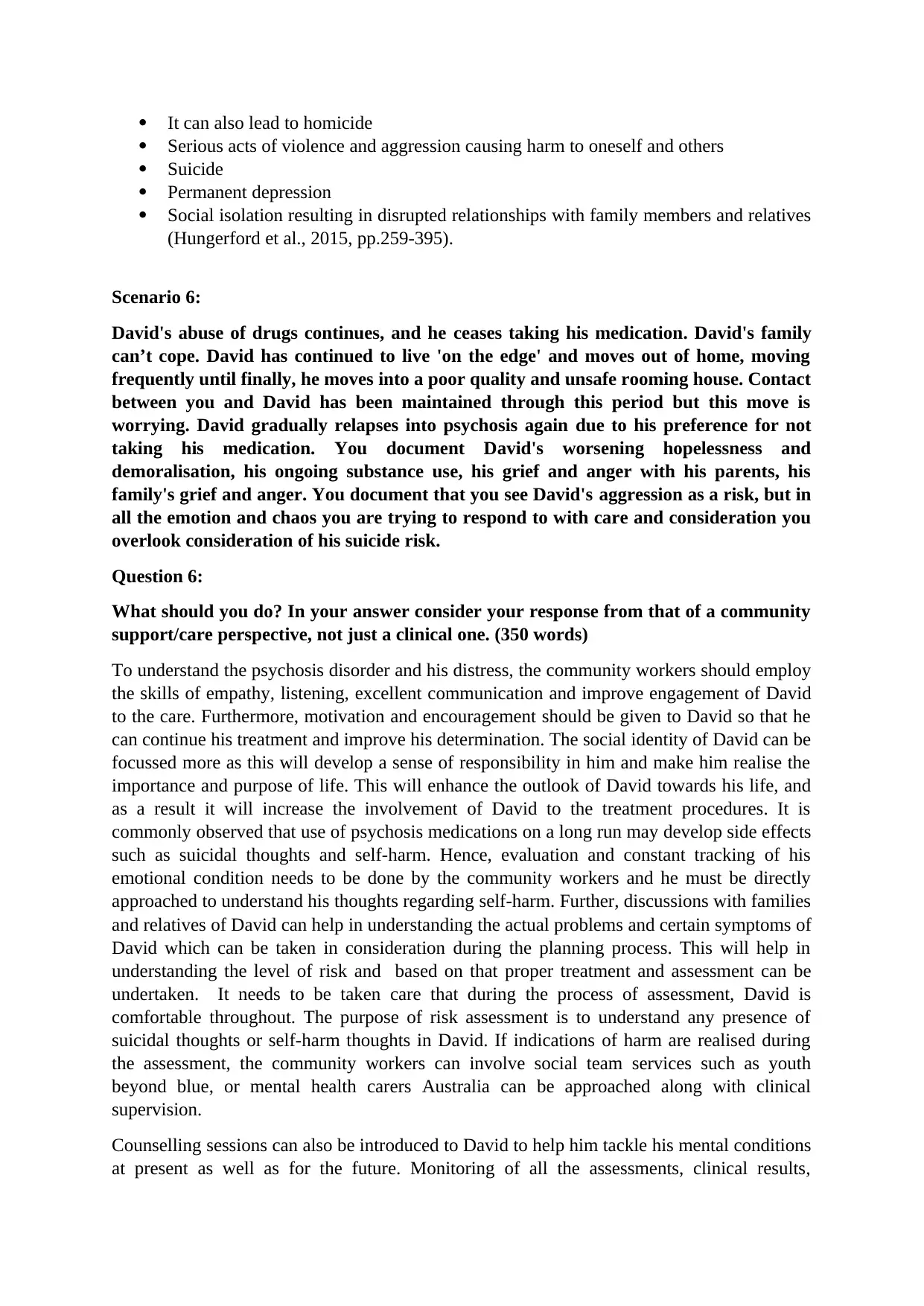
It can also lead to homicide
Serious acts of violence and aggression causing harm to oneself and others
Suicide
Permanent depression
Social isolation resulting in disrupted relationships with family members and relatives
(Hungerford et al., 2015, pp.259-395).
Scenario 6:
David's abuse of drugs continues, and he ceases taking his medication. David's family
can’t cope. David has continued to live 'on the edge' and moves out of home, moving
frequently until finally, he moves into a poor quality and unsafe rooming house. Contact
between you and David has been maintained through this period but this move is
worrying. David gradually relapses into psychosis again due to his preference for not
taking his medication. You document David's worsening hopelessness and
demoralisation, his ongoing substance use, his grief and anger with his parents, his
family's grief and anger. You document that you see David's aggression as a risk, but in
all the emotion and chaos you are trying to respond to with care and consideration you
overlook consideration of his suicide risk.
Question 6:
What should you do? In your answer consider your response from that of a community
support/care perspective, not just a clinical one. (350 words)
To understand the psychosis disorder and his distress, the community workers should employ
the skills of empathy, listening, excellent communication and improve engagement of David
to the care. Furthermore, motivation and encouragement should be given to David so that he
can continue his treatment and improve his determination. The social identity of David can be
focussed more as this will develop a sense of responsibility in him and make him realise the
importance and purpose of life. This will enhance the outlook of David towards his life, and
as a result it will increase the involvement of David to the treatment procedures. It is
commonly observed that use of psychosis medications on a long run may develop side effects
such as suicidal thoughts and self-harm. Hence, evaluation and constant tracking of his
emotional condition needs to be done by the community workers and he must be directly
approached to understand his thoughts regarding self-harm. Further, discussions with families
and relatives of David can help in understanding the actual problems and certain symptoms of
David which can be taken in consideration during the planning process. This will help in
understanding the level of risk and based on that proper treatment and assessment can be
undertaken. It needs to be taken care that during the process of assessment, David is
comfortable throughout. The purpose of risk assessment is to understand any presence of
suicidal thoughts or self-harm thoughts in David. If indications of harm are realised during
the assessment, the community workers can involve social team services such as youth
beyond blue, or mental health carers Australia can be approached along with clinical
supervision.
Counselling sessions can also be introduced to David to help him tackle his mental conditions
at present as well as for the future. Monitoring of all the assessments, clinical results,
Serious acts of violence and aggression causing harm to oneself and others
Suicide
Permanent depression
Social isolation resulting in disrupted relationships with family members and relatives
(Hungerford et al., 2015, pp.259-395).
Scenario 6:
David's abuse of drugs continues, and he ceases taking his medication. David's family
can’t cope. David has continued to live 'on the edge' and moves out of home, moving
frequently until finally, he moves into a poor quality and unsafe rooming house. Contact
between you and David has been maintained through this period but this move is
worrying. David gradually relapses into psychosis again due to his preference for not
taking his medication. You document David's worsening hopelessness and
demoralisation, his ongoing substance use, his grief and anger with his parents, his
family's grief and anger. You document that you see David's aggression as a risk, but in
all the emotion and chaos you are trying to respond to with care and consideration you
overlook consideration of his suicide risk.
Question 6:
What should you do? In your answer consider your response from that of a community
support/care perspective, not just a clinical one. (350 words)
To understand the psychosis disorder and his distress, the community workers should employ
the skills of empathy, listening, excellent communication and improve engagement of David
to the care. Furthermore, motivation and encouragement should be given to David so that he
can continue his treatment and improve his determination. The social identity of David can be
focussed more as this will develop a sense of responsibility in him and make him realise the
importance and purpose of life. This will enhance the outlook of David towards his life, and
as a result it will increase the involvement of David to the treatment procedures. It is
commonly observed that use of psychosis medications on a long run may develop side effects
such as suicidal thoughts and self-harm. Hence, evaluation and constant tracking of his
emotional condition needs to be done by the community workers and he must be directly
approached to understand his thoughts regarding self-harm. Further, discussions with families
and relatives of David can help in understanding the actual problems and certain symptoms of
David which can be taken in consideration during the planning process. This will help in
understanding the level of risk and based on that proper treatment and assessment can be
undertaken. It needs to be taken care that during the process of assessment, David is
comfortable throughout. The purpose of risk assessment is to understand any presence of
suicidal thoughts or self-harm thoughts in David. If indications of harm are realised during
the assessment, the community workers can involve social team services such as youth
beyond blue, or mental health carers Australia can be approached along with clinical
supervision.
Counselling sessions can also be introduced to David to help him tackle his mental conditions
at present as well as for the future. Monitoring of all the assessments, clinical results,
⊘ This is a preview!⊘
Do you want full access?
Subscribe today to unlock all pages.

Trusted by 1+ million students worldwide

behavioural pattern, medication and its dosage needs to be done and based on that improved
strategies should be implemented. Moreover, the relationship of David with his parents needs
to be assessed and based on that, discussions with his family needs to be made to improve the
relation. For example, David’s parents can be made aware of the crisis that David is
undergoing and the importance of their contribution in improving his condition by the means
of support. Furthermore, help of community services can be approached for better results.
(Hungerford et al., 2015, pp.200-395).
strategies should be implemented. Moreover, the relationship of David with his parents needs
to be assessed and based on that, discussions with his family needs to be made to improve the
relation. For example, David’s parents can be made aware of the crisis that David is
undergoing and the importance of their contribution in improving his condition by the means
of support. Furthermore, help of community services can be approached for better results.
(Hungerford et al., 2015, pp.200-395).
1 out of 7
Related Documents
Your All-in-One AI-Powered Toolkit for Academic Success.
+13062052269
info@desklib.com
Available 24*7 on WhatsApp / Email
![[object Object]](/_next/static/media/star-bottom.7253800d.svg)
Unlock your academic potential
Copyright © 2020–2025 A2Z Services. All Rights Reserved. Developed and managed by ZUCOL.





